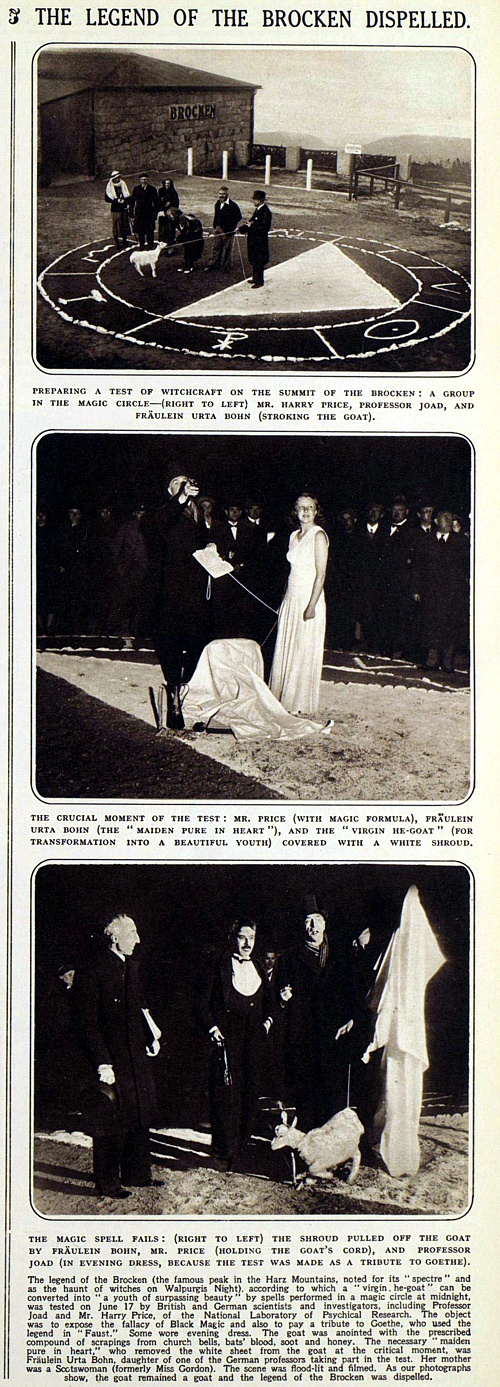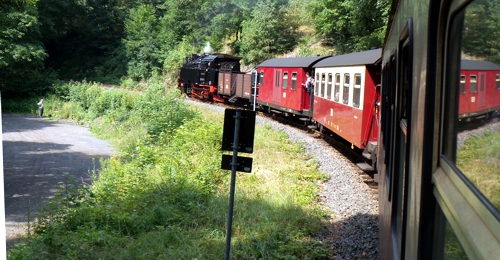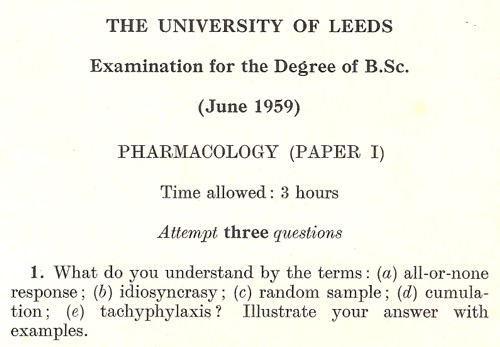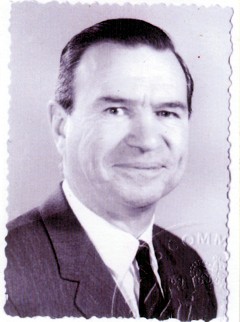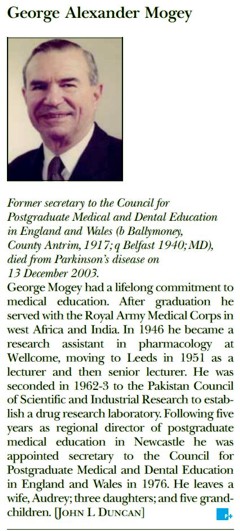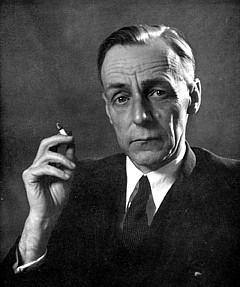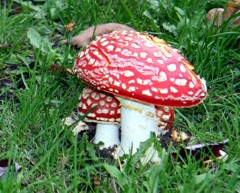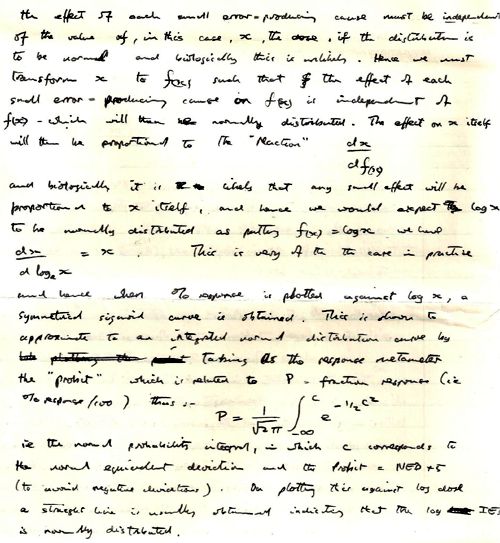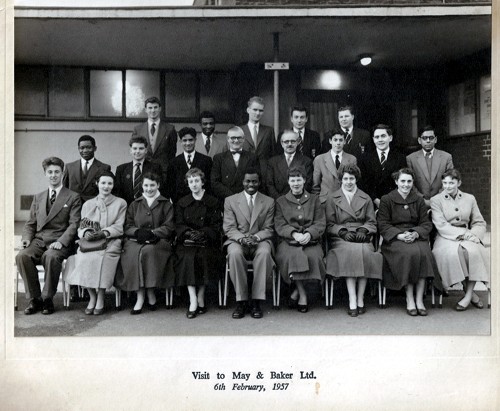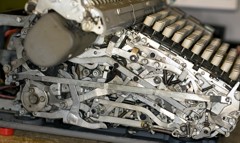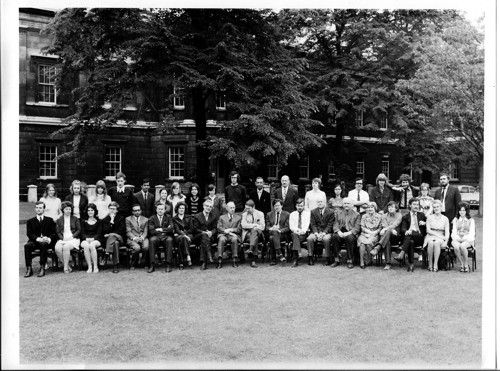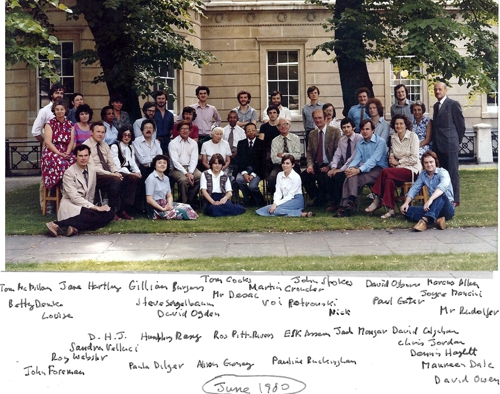George Mogey
This post follows directly from “Some pharmacological history: an exam from 1959“. In that post, I related how two of my teachers in Leeds, James Dare and George Mogey, had encouraged my interest in statistcs. George Mogey had worked previously at the famous Wellcome Research Labs in Beckenham, Kent. He had been there at the same time as J.W. Trevan, who pioneered accurate methods of biological assay.
Another person who overlapped with Mogey and Trevan at Beckenham was C.L. Oakley. I’m told by Audrey Mogey, George’s widow, that they were good friends of the Oakleys and that probably explains why George Mogey introduced me to Cyril Oakley, who had the chair of bacteriology at Leeds while I was an undergraduate there. Oakley’s Biographical Memoir makes no mention of statistics. The only person I’ve located who knew him is Keith Holland (professor of microbiology at Leeds). He told me
“I was trained by CLO between !961-65 and he inspired me to remain in research into aspects of anaerobic bacteriology and I attended his lectures on statistics, which were highly stimulating and humorous. He frequently used examples of magicians turning lead into gold and I can not recall examples of goats and men.”
The statistical connection stems from an article that was written by Oakley in 1943, Oakley, C. L. (1943). “He-goats into young men: first steps in statistics”, University College Hospital Magazine Vol 28, 16-21. Now you can download a copy of this rather obscure publication.
The action occurs on the Brocken. The paper starts by citing the Illustrated London News (the internet of its age). In 1932 an experiment was done which allegedly dispelled the legend of the Brocken. Here it is.
Oakley uses the Brocken experiment to explain the statistical method known as probit analysis. This was obviously something he’d learned from J.W. Trevan during his time at the Beckenham lab (e.g his classic 1927 paper, The Error of Determination of Toxicity) . And it was my meeting with Oakley, as an undergraduate, that caused me to use his paper as the basis of a section in Lectures on Biostatistics.
It also explains why, ever since the late 50s, I’ve wanted to visit the Brocken. It’s only about 100 km from Göttingen, where I worked often between 1980 and 1985, but at that time the Brocken was in East Germany. I remember looking across the wall at the Harz mountains, when Erwin Neher took us into the country to pick wild bilberries (blueberries, Heidelbeeren). Reunification of Germany occurred while I was working in Heidelberg in 1991 but it was not until a month ago that I got there. We took a rail tour of Germany, and spent four days in the Harz town of Wernigerode, from where we took the Harzer Schmalspurbahn, the steam powered narrow gauge railway, to the Brocken. Here are some pictures of the trip (click first picture for an album)..
All I got was a teapot stand, with a witch on a broomstick (and I don’t even drink the stuff myself).

Interestingly, although there is plenty of tourist tat about the connection with Dr Faust and Goethe, I didn’t find any German who’d heard of the he-goat conversion legend. One of the people involved in the experiment, Harry Price (1881 – 1948) of the National Laboratory of Psychical Research seems to have been behind it, and the history is described by him in the “Bloksberg Tryst” (Blocksberg is another name for the Brocken). Another person who conducted the experiment was Professor Joad (1891 – 1953). I can just remember hearing him on the BBC Home Service (radio) programme, the Brains Trust, which also featured Julian Huxley and Jacob Bronowski (1908 -1974). They were the public intellectuals of the early 1950s. (Much later, I discovered that Bronowski was the father of Lisa Jardine, who now works at UCL).
Oakley (1943) starts by citing the account in the Illustrated London News.
“The legend of the Brocken (the famous peak in the Harz Mountains, noted for its spectre and as the haunt of witches on Walpurgis Night), according to which a virgin he-goat can be converted into “a youth of surpassing beauty” by spells performed in a magic circle at midnight, was tested on June 17 by British and German scientists and investigators, including Professor Joad and Mr. Harry Price, of the National Laboratory of Psychical Research. The object was to expose the fallacy of Black Magic and also to pay a tribute to Goethe, who used the legend in Faust. Some wore evening dress. The goat was anointed with the prescribed compound of scrapings from church bells, bats’ blood, soot and honey. The necessary maiden pure in heart, who removed the white sheet from the goat at the critical moment, was Fräulein Urta Bohn, daughter of one of the German professors taking part in the test. Her mother was a Scotswoman (formerly Miss Gordon). The scene was flood-lit and filmed. As our photographs show, the goat remained a goat and the legend of the Brocken was dispelled”.
Oakley then proposes a biological assay to measure purity in heart.
“It will he observed that the only incompletely controllable variables in the experiment (excluding Iocal variations in the church bells, bat’s blood, soot and honey) are the virgin he-goat and the maiden (virgin?) pure in heart. Virginity may for the present be regarded as an absolute character —purity in heart no doubt varies from person to person.. If, therefore, a reasonably uniform supply of virgin he-goats be obtained, and the percentage of he-goats converted bears
any relation to the purity in heart of the maiden used, we ought appear “>to
be able to measure the degree of purity in heart of the virgins available.”
The argument he uses is based directly on J.W. Trevan. The story reappeared in Chapter 7 (section 7.8, page 111) of Lectures on Biostatistics, where I used it to illustrate confidence intervals for a binomial proportion.
“We shall assume, as Oakley did, that the conversion of he-goats into young men is an all-or-nothing process; either complete conversion or nothing occurs. Oakley supposed, on this basis, that a comparison could be made between, on one hand, the percentage of he-goats converted by maidens of various degrees of purity in heart, and, on the other hand, the sort of pharmacological experiment that involves the measurement of the percentage of individuals showing a specified
effect in response to various doses of a drug. In conformity with the common pharmacological practice he supposed that a plot of percentage he-goat conversion against log purity in heart index (log PHI) would have the sigmoid form shown in Fig. 14.2.4. As explained in Chapter 14, this implies that log PHI required to convert individual he-goats is a normally distributed variable. Furthermore it means that infinite purity in heart is required to produce a population he-goat
conversion rate (HGCR) of 100 per cent..
Although there is a lack of experimental evidence on this point, the present author feels that the assumption of a normal distribution is, as so often happens, without foundation (see § 4.2). The implication of the normality assumption, that there exist he-goats so resistant to conversion that infinite purity in heart is needed to affect them, has
not been (and cannot be) experimentally verified. Furthermore the very idea of infinite purity in heart seems likely to cause despondency in most people, and should therefore be avoided until such time as its necessity may be demonstrated experimentally.”
In the light of these remarks it appears to the present author desirable that the purity in heart index should be redefined simply as the population percentage of he-goats converted. This simple operational definition means that the PHI of all maidens will fall between 0 and 100, and confidence limits for the true PHI can be found easily from the observed conversion rate (which should be binomially distributed, see §§ 3.2-3.5) using Table A2, as explained in §7.7.
For example, if it were observed that a particular maiden caused conversion of r = 2 out of n = 4 he-goats, the estimated PHI would be 100 × 2/4 = 50 per cent, and, from Table A2, confidence limits (P = 0·95) for true PHI are 6.8 – 93.2 per cent. Clearly the information be gained from a sample of only four he-goats is so imprecise that it difficult to conceive what use it could be put to. Oakley recommended that for preliminary experiments at least n = 10 he-goats should be used. If r = 5 (50 per cent) of these were observed to be converted Table A2 would give the confidence limits (P = 0·95) for the true PHI as 18·7 — 81·3 per cent. While the most extreme forms of vice and of virtue appear to be ruled out by this result, there is still considerable uncertainty about the PHI. If a greater degree of confidence were required, as for example, if a potential husband demanded a certain minimum (or, alternatively, a certain maximum) PHI before committing himself, the P = 0.99 confidence limits could found from Table A2. They are 12.8 — 87.2 per cent. The most tolerant suitor might be forgiven for requiring a larger sample.”
The statistics are pretty standard stuff. You can find out more by downloading Lectures on Biostatistics. The binomial distribution in Chapters 3, 7 and 8. Probit analysis is described in Chapter 14.
For some real statistics, please look at “An investigation of the false discovery rate and the misinterpretation of P values“, now available as a preprint on arXiv.
Follow-up
Last year, I was sent my answer paper for one of my final exams, taken in 1959. This has triggered a bout of shamelessly autobiographical nostalgia.
|
The answer sheets that I wrote had been kept by one of my teachers at Leeds, Dr George Mogey. After he died in 2003, aged 86, his widow, Audrey, found them and sent them to me. And after a hunt through the junk piled high in my office, I found the exam papers from that year too. George Mogey was an excellent teacher and a kind man. He gave most of the lectures to medical students, which we, as pharmacy/pharmacology students attended. His lectures were inspirational. |
|
Today, 56 years on, I can still recall vividly his lecture on anti-malarial drugs. At the end he paused dramatically and said “Since I started speaking, 100 people have died from malaria” (I don’t recall the exact number). He was the perfect antidote to people who say you learn nothing from lectures. Straight after the war (when he had seen the problem of malaria at first hand) he went to work at the Wellcome Research Labs in Beckenham, Kent. The first head of the Wellcome Lab was Henry Dale. It had a distinguished record of basic research as well as playing a crucial role in vaccine production and in development of the safe use of digitalis. In the 1930s it had an important role in the development of proper methods for biological standardisation. This was crucial for ensuring that, for example, each batch of tincture ot digitalis had the same potency (it has been described previously on this blog in Plants as Medicines. |
|
When George Mogey joined the Wellcome lab, its head was J.W. Trevan (1887 – 1956) (read his Biographical Memoir, written by J.H. Gaddum). Trevan’s most memorable contributions were in improving the statistics of biological assays. The ideas of individual effective dose and median effective dose were developed by him. His 1927 paper The Error of Determination of Toxicity is a classic of pharmacology. His advocacy of the well-defined quantity, median effective dose as a replacement for the ill-defined minimum effective dose was influential in the development of proper statistical analysis of biological assays in the 1930s. |
Trevan is something of hero to me. And he was said to be very forgetful. Gaddum, in his biographical memoir, recounts this story
“One day when he had lost something and suspected that it had been tidied away by his secretary, he went round muttering ‘It’s all due to this confounded tidiness. It always leads to trouble. I won’t have it in my lab.’ “
|
Trevan coined the abbreviation LD50 for the median lethal dose of a drug. George Mogey later acquired the car number plate LD50, in honour of Trevan, and his widow, Audrey, still has it (picture on right). |
Mogey wrote several papers with Trevan. In 1948 he presented one at a meeting of the Physiological Society. The programme included also A.V. Hill. E.J Denton, Bernhard [sic] Katz, J.Z. Young and Richard Keynes (Keynes was George Henry Lewes Student at Cambridge: Lewes was the Victorian polymath with whom the novelist George Eliot lived, openly unmarried, and a founder of the Physiological Society. He probably inspired the medical content of Eliot’s best known novel, Middlemarch).
|
Mogey may not have written many papers, but he was the sort of inspiring teacher that universities need. He had a letter in Nature on Constituents of Amanita Muscaria, the fly agaric toadstool, which appeared in 1965. That might explain why we went on a toadstool-hunting field trip. |
The tradition of interest in statistics and biological assay must have rubbed off on me, because the answers I gave in the exam were very much in that tradition. Here is a snippet (click to download the whole answer sheet).
A later answer was about probit analysis, an idea introduced by statistician Chester Bliss (1899–1979) in 1934, as an direct extension of Trevan’s work. (I met Bliss in 1970 or 1971 when I was in Yale -we had dinner, went to a theatre -then back to his apartment where he insisted on showing me his collection of erotic magazines!)
This paper was a pharmacology paper in my first final exam at the end of my third year. The external examiner was Walter Perry, head of pharmacology in Edinburgh (he went on to found the Open University). He had previously been head of Biological Standards at the National Institute for Medical Research, a job in which he had to know some statistics. In the oral exam he asked me a killer question “What is the difference between confidence limits and fiducial limits?”. I had no real idea (and, as I discovered later, neither did he). After that, I went on to do the 4th year where we specialised in pharmacology, and I spent quite a lot of time trying to answer that question. The result was my first ever paper, published in the University of Leeds Medical Journal. I hinted, obliquely, that the idea of fiducial inference was probably Ronald Fisher‘s only real mistake. I think that is the general view now, but Fisher was such a towering figure in statistics that nobody said that straight out (he was still alive when this was written -he died in 1962).
It is well-worth looking at a paper that Fisher gave to the Royal Statistical Society in 1935, The Logic of Inductive Inference. Then, as now, it was the custom for a paper to be followed by a vote of thanks, and a seconder. These, and the subsequent discussion, are all printed, and they could be quite vicious in a polite way. Giving the vote of thanks, Professor A.L. Bowley said
“It is not the custom, when the Council invites a member to propose a vote of thanks on a paper, to instruct him to bless it. If to some extent I play the inverse role of Balaam, it is not without precedent;”
And the seconder, Dr Isserlis, said
“There is no doubt in my mind at all about that, but Professor Fisher, like other fond parents, may perhaps see in his offspring qualities which to his mind no other children possess; others, however, may consider that the offspring are not unique.”
Post-publication peer review was already alive and well in 1935.
I was helped enormously in writing this paper by Dr B.L.Welch (1911 – 1989), whose first year course in statistics for biologists was a compulsory part of the course. Welch was famous particularly for having extended Student’s t distribution to the case where the variances in two samples being compared are unequal (Welch, 1947). He gave his whole lecture with his back to the class while writing what he said on a set of blackboards that occupied the whole side of the room. No doubt he would have failed any course about how to give a lecture. I found him riveting. He went slowly, and you could always check your notes because it was all there on the blackboards.
Walter Perry seemed to like my attempt to answer his question, despite the fact that it failed. After the 4th year final (a single 3 hour essay on drugs that affect protein synthesis) he offered me a PhD place in Edinburgh. He was one of my supervisors, though I never saw him except when he dropped into the lab for a cigarette between committee meetings. While in Edinburgh I met the famous statistician. David Finney, whose definitive book on the Statistics of Biological Assay was an enormous help when I later wrote Lectures on Biostatistics and a great help in getting my first job at UCL in 1964. Heinz Otto Schild. then the famous head of department, had written a paper in 1942 about the statistical analysis of 2+2 dose biological assays, while interned at the beginning of the war. He wanted someone to teach it to students, so he gave me a job. That wouldn’t happen now, because that sort of statistics would be considered too difficult Incidentally, I notice that Schild uses 99% confidence limits in his paper, not the usual 95% limits which make your results look better
It was clear even then, that the basis of statistical inference was an exceedingly contentious matter among statisticians. It still is, but the matter has renewed importance in view of the crisis of reproducibility in science. The question still fascinates me, and I’m planning to update my first paper soon. This time I hope it will be a bit better.
Postscript: some old pictures
While in nostalgic mood, here are a few old pictures. First, the only picture I have from undergraduate days. It was taken on a visit to May and Baker (of sulphonamide fame) in February 1957 (so I must have been in my first year). There were 15 or so in the class for the first three years (now, you can get 15 in a tutorial group). I’m in the middle of the back row (with hair!). The only names that I recall are those of the other two who went into the 4th year with me, Ed Abbs (rightmost on back row) and Stella Gregory (2nd from right, front row). Ed died young and Stella went to Australia. Just in front of me are James Dare (with bow tie) and Mr Nelson (who taught old fashioned pharmacognosy).
|
James Dare taught pharmaceutics, but he also had a considerable interest in statistics and we did lots of calculations with electromechanical calculators -the best of them was a Monroe (here’s a picture of one with the case removed to show the amazingly intricate mechanism). |
>
Monroe 8N-213 from http://www.science.uva.nl/museum/calclist.php |
The history of UCL’s pharmacology goes back to 1905. For most of that time, it’s been a pretty good department. It got top scores in all the research assessments until it was abolished by Malcolm Grant in 2007. That act of vandalism is documented in my diary section.
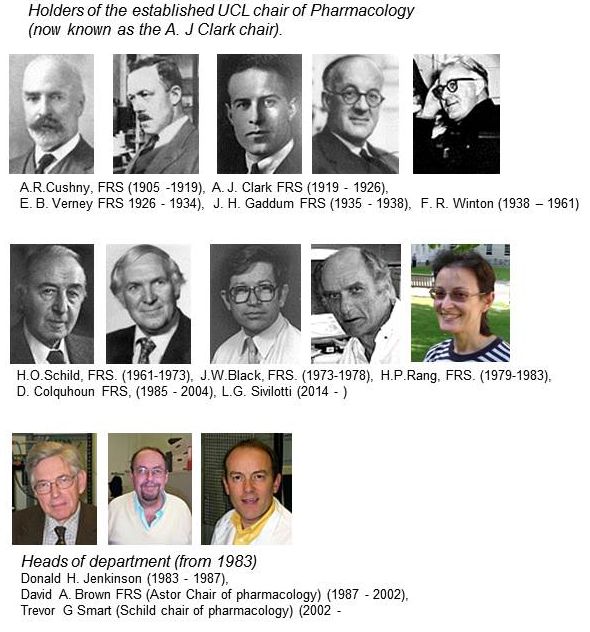
For most of its history, there was one professor who was head of the department. That tradition ended in 1983,when Humphrey Rang left for Novartis. The established chair was then empty for two years, until Donald Jenkinson, then head of department, insisted with characteristic modesty, that I rather than he should take the chair. Some time during the subsequent reign of David Brown, it was decided to name the chairs, and mine became the A.J. Clark chair. It was decided that the headship of the department would rotate, between Donald, David Brown and me. But when it came to my turn, I decided I was much too interested in single ion channels to spend time pushing paper, and David Brown nobly extended his term. The A.J. Clark chair was vacant after I ‘retired’ in 2004, but in 2014, Lucia Sivilotti was appointed to the chair, a worthy successor in its quantitative tradition.
The first group picture of UCL’s Pharmacology department was from 1972. Heinz Schild is in the middle of the front row, with Desmond Laurence on his left. Between them they dominated the textbook market: Schild edited A.J. Clark’s Pharmacology (now known as Rang and Dale). Laurence wrote a very successful text, Clinical Pharmacology. Click on the picture for a bigger version, with names, as recalled by Donald Jenkinson: (DHJ). I doubt whether many people now remember Ada Corbett (the tea lady) or Frank Ballhatchet from the mechanical workshop. He could do superb work, though the price was to spent 10 minutes chatting about his Land Rover, or listening to reminiscences of his time working on Thames barges. I still have a beautiful 8-way tap that he made. with a jerk-free indexing mechanism.
The second Departmental picture was taken in June 1980. Humphrey Rang was head of department then. My colleagues David Ogden and Steven Siegelbaum are there. In those days we had a tea lady too, Joyce Mancini. (Click pictures to enlarge)


